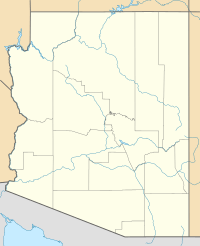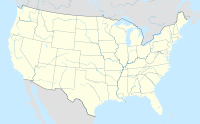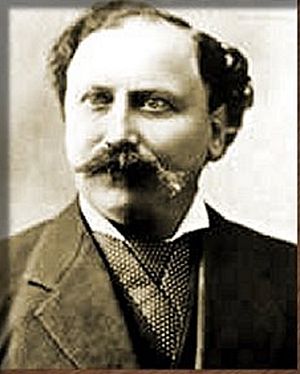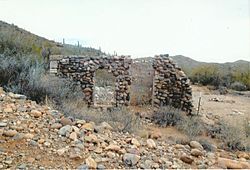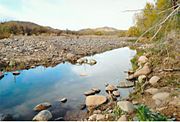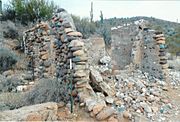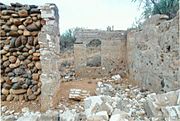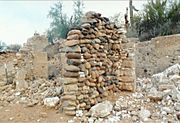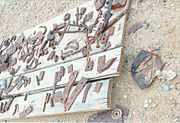Gillett, Arizona facts for kids
Quick facts for kids
Gillett, Arizona
|
|
|---|---|
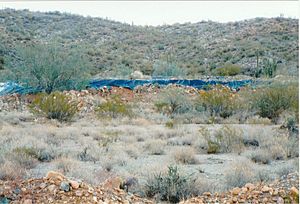
Location where the town of Gillett once stood.
|
|
| Country | United States |
| State | Arizona |
| County | Yavapai |
| Founded | 1878 |
| Abandoned | 1880 |
| Elevation | 1,834 ft (559 m) |
| Population
(2009)
|
|
| • Total | 0 |
| Time zone | UTC-7 (MST (no DST)) |
| FIPS code | 04-27505 |
| GNIS feature ID | 24431 |
| Post Office opened | October 15, 1878 |
| Post Office closed | August 11, 1887 |
Gillett, Arizona, often misspelled as "Gillette" on maps, is a ghost town in Yavapai County, Arizona. It sits about 1,362 feet (415 meters) above sea level. Gillett started as a stagecoach stop. Later, a settlement grew around a mill that processed ore from the Tip Top Mine. This mill was located on the Agua Fria River in what was then Arizona Territory. The town was named after Dan B. Gillett, who developed the Tip Top Mine.
Contents
The Rise of Gillett: A Mining Town's Story
Gillett was founded in 1878 by the person in charge of the Tip Top Mine. He decided to build the mill here to process the ore, which came from Tip Top, about nine miles away. The town's post office opened on October 15, 1878.
Life in Gillett: What the Town Had
At its busiest in 1878, Gillett was a lively place. It had six streets and many businesses. Besides the mill and post office, there was a bank and an assay office (where minerals were tested). The town also had a hotel, a real estate office, and a place to keep horses. You could find a lumberyard, a meat market, and a farm that grew vegetables. There was also a dairy, a warehouse, and two blacksmith shops. Gillett had two stagecoach stations, four stores, and nine saloons or gambling houses.
Jack Swilling: A Founder's Journey
Jack Swilling, who helped found the city of Phoenix, and his wife Trinidad had several businesses in Gillett. They owned "Gillett Real Estate," selling land plots for $100 to $250. They also had a ranch for cattle and horses. Plus, they ran a vegetable farm with a partner named L.A. Stephens.
A Friend's Burial and a Misunderstanding
In the spring of 1878, the Swillings heard sad news. Their family friend, Colonel Jacob Snively, had been killed by Apaches. This happened in the Wickenburg Mountains near a peak called White Picacho. Mrs. Swilling suggested that Jack and two friends, Andrew Kirby and George Monroe, go find his remains. They wanted to give him a proper burial.
On April 17, Jack and his friends went on their trip. They returned to Gillett on April 23, bringing Colonel Snively's remains. Jack was seen walking in Gillett with a bag holding the bones. He buried them on his property next to his house.
The Wickenburg Massacre and False Accusations
Around this time, a stagecoach near Wickenburg was robbed. Several people were killed, including a young writer named Frederick Wadsworth Loring. This event became known as the Wickenburg Massacre. One day, Jack Swilling and his friends were talking about the robbery in a saloon in Gillett. Jack jokingly said that he and his friends matched the description of the robbers. Because of this joke, they became suspects in the robbery.
Pima County Sheriff Wiley W. Standefer arrested Jack Swilling and Andrew Kirby. They were later taken to a federal jail in Yuma. Jack Swilling became very ill while waiting for his hearing. He passed away on August 12. Later, the real criminals were caught, proving Jack's innocence. He was buried in an unmarked grave at the prison cemetery before his family could be told.
The Gillett Treasure: A Bandit's Secret
Gillett had its share of exciting stories, including tales of outlaws. One such story is about Henry Seymour, the town's blacksmith. Seymour secretly robbed the Wells Fargo stagecoach before it reached town. In 1882, he held up three coaches by himself. No one suspected him because he was always back in his shop before the stagecoach arrived. He stole a total of $68,000 from these three robberies. People called him the "Ghost Bandit."
How the Ghost Bandit Was Caught
Normally, Seymour would hide his stolen money. But one time, he used some of the money from a robbery in a poker game at a local saloon. This made people suspicious. Maricopa County Sheriff Lindley Orme sent his deputy, Henry Garfias, to investigate. Witnesses told Garfias that on the day of the last robbery, they saw Henry Seymour with a rifle and some sacks. Garfias suspected Seymour was the Ghost Bandit. He decided to set a trap.
When Garfias learned the next stagecoach was coming to Gillett, he hid near the Agua Fria crossing. He waited. As soon as he saw Seymour, who was carrying a rifle, Garfias arrested him. Seymour, the "Ghost Bandit," was finally caught trying to rob his fourth stagecoach that year. He was sent to prison. Seymour never told anyone where he hid his treasure. When he was released from prison, he never returned to Gillett. Henry Garfias later became the first marshal of Phoenix.
The Decline of Gillett: A Town Fades Away
After the mill closed in 1880 and moved to Tip Top in 1884, the town of Gillett was soon abandoned. The post office continued for a few more years but closed in August 1887. All that remained was one store, a stagecoach station, and only two people living there.
A Dangerous Route and Final Abandonment
The stagecoach station was part of the Black Canyon wagon road. This route around Gillett was surrounded by large rocks and bushes. This made it easy for robbers to hide and ambush stagecoaches. The trail became very dangerous to travel on. Because of the danger, the Wells Fargo Express Company stopped sending shipments along this route. The stagecoach station stayed open until 1912, when it was also abandoned. The Burfind Hotel was the biggest building in Gillett. Today, only its ruins and a forgotten cemetery remain.
Visiting Gillett Today
Even though it's a ghost town, the U.S. Geological Survey and the U.S. Census Bureau still list Gillett as a populated place. Tourists and locals can visit the site. To get there, take Interstate 17 (I-17) North and exit at Table Mesa Road. Drive west on Table Mesa Road, cross the shallow Agua Fria River, and continue for about 0.3 miles to Gillett. The exact location is N 34° 01' 07.5" W 112° 09' 49.3". Remember, the property is now private, so you need the owner's permission to visit.
Gallery – The Burfind Hotel and Other Scenes


